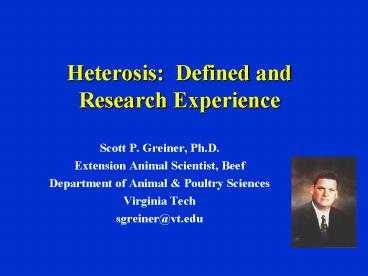Heterosis: Defined and Research Experience - PowerPoint PPT Presentation
1 / 21
Title:
Heterosis: Defined and Research Experience
Description:
Cows that are low-cost, adaptable to feed and environmental resources ... Heterosis offers best genetic solution for improvement of lowly heritable reproductive traits ... – PowerPoint PPT presentation
Number of Views:330
Avg rating:3.0/5.0
Title: Heterosis: Defined and Research Experience
1
Heterosis Defined and Research Experience
- Scott P. Greiner, Ph.D.
- Extension Animal Scientist, Beef
- Department of Animal Poultry Sciences
- Virginia Tech
- sgreiner_at_vt.edu
2
Can We Have It All???
- Reproductively efficient cow herd
- Cows that are low-cost, adaptable to feed and
environmental resources - Superior growth/feed efficiency
- End product merit
3
Crossbreeding Fundamentals
- Heterosis (Hybrid Vigor)
- Individual heterosis
- Maternal heterosis
- Paternal heterosis
- Breed complementarity
4
Heterosis Defined-Superiority of crossbred
animal relative to average of its straightbred
parents
- Breed A Weaning Wt. 530 lb.
- Breed B Weaning Wt. 470 lb.
- A x B Crossbred Calf
- Expected performance 500 lb. (average of A
and B) - Actual performance 520 lb.
- 20 lb. (4) increase heterosis
5
Genetic Basis of Heterosis
- Additive vs. non-additive gene effects
- Additive favorable effect on performance results
from increase in homozygosity (heterozygote
intermediate to homozygotes) - Non-additive favorable effects realized through
increase in heterozygosity - Dominance and epistasis
6
Dominance
7
Economically Important Traits
- Reproductive efficiency
- Calving ease
- Calf survival
- Weaning Wt.
- Post-weaning growth
- Feed efficiency
- Mature size
- Red meat yield
- Palatability
8
Individual HeterosisAdvantage of the Crossbred
Calf
Cundiff and Gregory, 1999
9
Carcass Traits
Long, 1980
10
Maternal Heterosis
Cundiff and Gregory, 1999
11
Impact of Heterosis
Heritability Low Moderate High
Heterosis High High Low
Reproduction Growth Carcass Merit
12
Maternal HeterosisAdvantage of the Crossbred Cow
- Advantage of crossbred cow vs. straightbred
- Reproductive efficiency
- Maternal ability
- Longevity
- Increased lifetime productivity
- Maternal heterosis accounts for largest portion
of total heterosis advantage (60)
13
Estimating Heterosis
- Expected Performance
- General purebred mean
- ½ sire breed direct value
- ½ dam breed direct value
- dam breed maternal value
- individual heterosis
- maternal heterosis
14
Weaning Weight Example
- General mean 600
- Individual heterosis 4.0
- Maternal heterosis 4.0
15
Sire C x crossbred A-B dam
- Calculated performance with direct and maternal
breed values - 600 0.5(40) 0.25(20) 0.25(-10) 0.5(10)
0.5(30) 642.5 - Add individual heterosis
- 642.5 0.04(642.5) 668.2
- Add maternal heterosis
- 668.2 0.04(668.2) 694.9
16
Paternal HeterosisAdvantage of the Crossbred Sire
- Advantage in reproductive traits
- Realized primarily when single sires mated to
high numbers of cows (gt 40) - Difficult to measure due to large influence of
female in total herd reproductive efficiency
17
Breed Differences
source Cundiff et al., 2001, Germplasm
Evaluation Program Progress Report No. 21
18
Effect of breed type on level of heterosis
Cundiff and Gregory, 1999
19
Heterosis Bottom Line
- Heterosis offers best genetic solution for
improvement of lowly heritable reproductive
traits - Majority of heterosis advantages realized through
crossbred dams
20
Considerations
- Breed contributions
- Optimizing heterosis
- Heterosis retention
- Interaction with environment
- Economics of crossbreeding
- Sustainable systems to capture heterosis
21
Heterosis Defined and Research Experience
- Scott P. Greiner, Ph.D.
- Extension Animal Scientist, Beef
- Department of Animal Poultry Sciences
- Virginia Tech
- sgreiner_at_vt.edu































